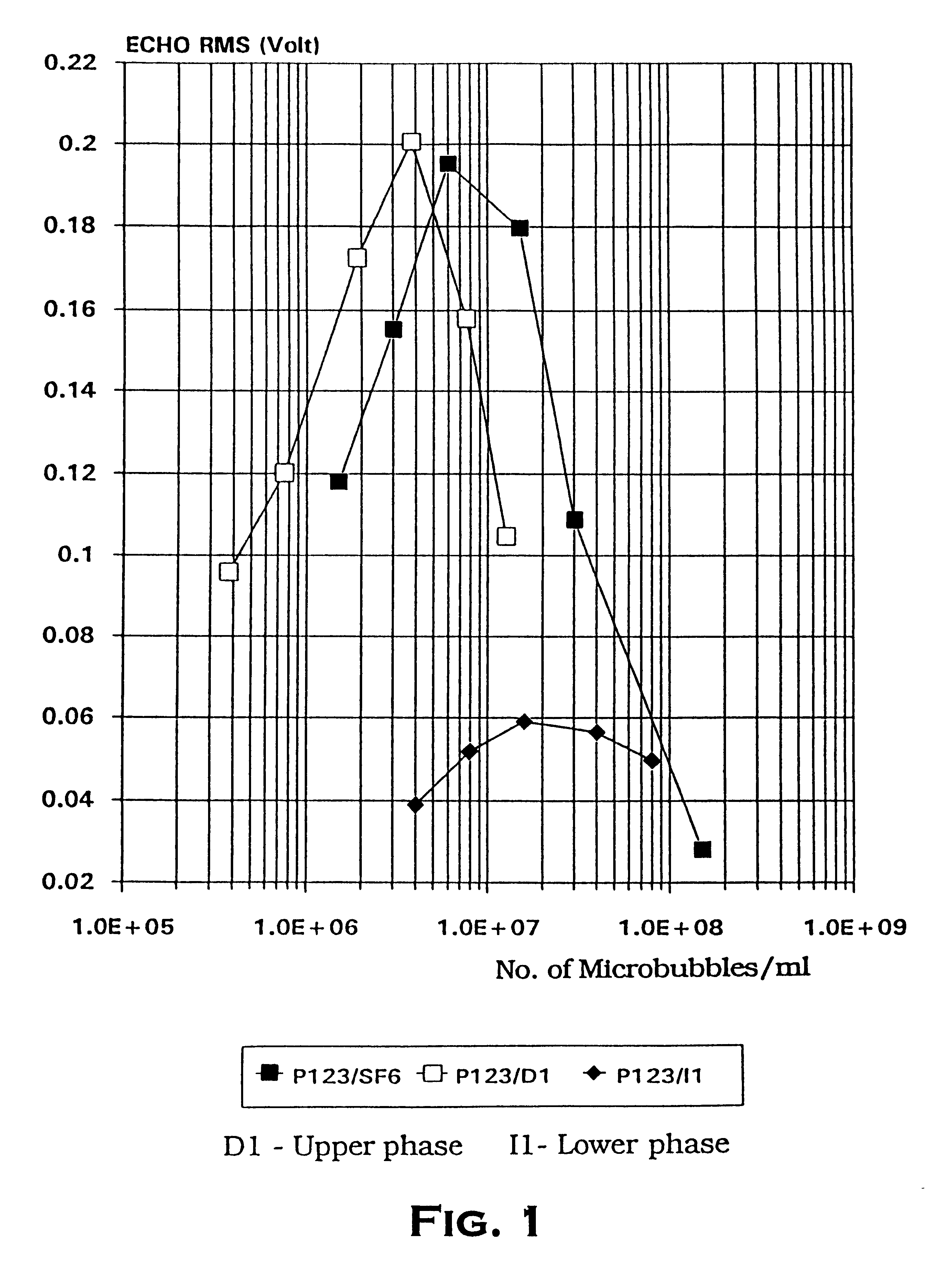Stable microbubble suspensions as enhancement agents for ultrasonic echography
a technology of ultrasonic echography and suspensions, which is applied in the direction of echographic/ultrasound-imaging preparations, ultrasonic/sonic/infrasonic image/data processing, catheters, etc., can solve the problems of affecting the practical use of the composition, affecting the quality of the composition, and affecting the effect of the composition
- Summary
- Abstract
- Description
- Claims
- Application Information
AI Technical Summary
Problems solved by technology
Method used
Image
Examples
example 2
Lyophilisates were prepared as described in Example 1 with air (instead of SF.sub.6) in the gas phase. The lyophilisates were then suspended in 0.9% saline (instead of a 3% glycerol solution). Similar bubble concentrations were obtained. However, after injection in the rabbit or the minipig the persistence of the effect was shorter e.g. 10-20 s instead of 120 s. Moreover, in the minipig the opacification of the left ventricle was poor even with the 10 mg / ml preparation.
example 3
MLV liposomes were prepared as described in Example 1 using 240 mg of DAPC and 10 mg of DPPA (molar ratio 95:5). Two milliliters of this preparation were added to 20 ml of a polyethyleneglycol (PEG 2'000) solution (82.5 mg / ml). After mixing for 10 min at room temperature, the resulting solution was frozen during 5 min at -45.degree. C. and lyophilised during 5 hours at 0.2 mbar. The powder obtained (1.6 g) was transferred into a glass vial equipped with a rubber stopper. The powder was exposed to SF.sub.6 (as described in Example 1) and then dissolved in 20 ml of distilled water. The suspension obtained showed a bubble concentration of 5.times.10.sup.9 bubbles per ml with a median diameter in volume of 5.5 .mu.m. This suspension was introduced into a 20 ml syringe, the syringe was closed and left in the horizontal position for 24 hours. A white layer of bubbles could be seen on the top of solution in the syringe. Most of the liquid phase (.about.16-18 ml) was evacuated while the syr...
example 4
A solution containing 48 mg of DAPC and 2 mg of DPPA in hexane / ethanol 8 / 2 (v / v) was prepared and the solvent evaporated to dryness (as described in Example 1). 5 mg of the resulting powder and 375 mg of polyethyleneglycol were dissolved in 5 g of tert-butanol at 60.degree. C. The clear solution was then rapidly cooled to -45.degree. C. and lyophilised. 80 mg of the lyophilisate was introduced in a glass vial and the powder exposed to SF.sub.6 (see Example 1). A 3% glycerol solution (10 ml) was then introduced in the vial and the lyophilisate dissolved by gentle swirling. The resulting suspension had 1.5.times.10.sup.8 bubbles per ml with a median diameter (in volume) of 9.5 .mu.m. This solution was injected to a rabbit providing outstanding views of the right and left ventricle. Even a ten fold dilution of this suspension showed strong contrast enhancement.
PUM
 Login to View More
Login to View More Abstract
Description
Claims
Application Information
 Login to View More
Login to View More - R&D
- Intellectual Property
- Life Sciences
- Materials
- Tech Scout
- Unparalleled Data Quality
- Higher Quality Content
- 60% Fewer Hallucinations
Browse by: Latest US Patents, China's latest patents, Technical Efficacy Thesaurus, Application Domain, Technology Topic, Popular Technical Reports.
© 2025 PatSnap. All rights reserved.Legal|Privacy policy|Modern Slavery Act Transparency Statement|Sitemap|About US| Contact US: help@patsnap.com


